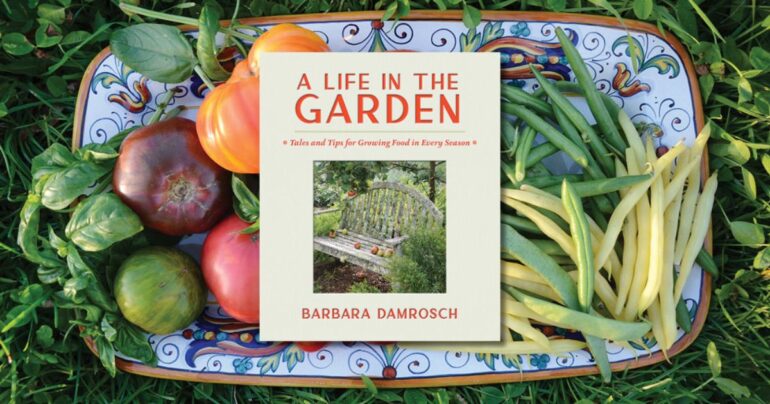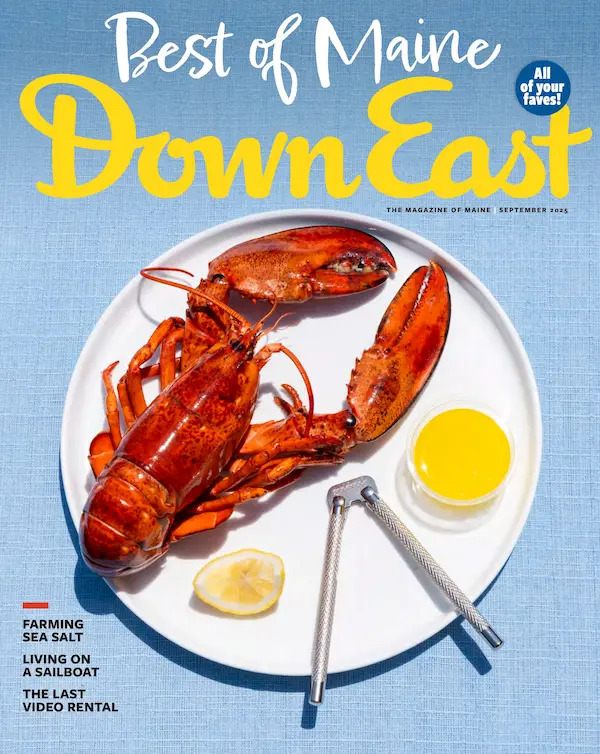By Michaela Cavallaro
From our October 2024 issue
Thirty-three years after she began farming on a Brooksville plot formerly owned by back-to-the-landers Helen and Scott Nearing, Barbara Damrosch remains utterly beguiled by what she manages to coax from the earth. “When my Italian honey fig started making fruits so full of sweet nectar that they would plop into my outstretched hand,” she writes in A Life in the Garden (Timber Press; hardcover; $40), “I was quick to tell the greedy rooted tree, ‘Go ahead. Take over my little greenhouse. Take over my life.’ That could happen with a tomato. Or a melon.”
Tomatoes get their own chapter in the volume, a guide to growing organic food Damrosch calls “a memoir-y gardening book,” while other plants are grouped by category. Throughout, Damrosch mixes practical advice on starting seeds, fostering fertile soil, designing efficient garden layouts, and more, with personal anecdotes from her decades running Four Season Farm with her husband, fellow author and gardening guru Eliot Coleman, whom she met in the Nearings’s greenhouse in 1991. The couple has published seven organic-gardening books between them. Damrosch hopes her latest plants a seed. “I wanted to make gardening contagious,” she says. “This is what you can do. This is the joy you can get out of it.”




Who is this book for?
The reader is somebody who either already gardens or would like to. And then there will be a few readers who don’t garden at all but are interested in us. I became pretty well known for The Garden Primer [her 1988 book on flower and vegetable gardening]. But then I married Eliot, and Eliot was kind of a hottie. He was well-known. We filmed several seasons of the show Gardening Naturally on the Learning Channel years ago. And so I think some people continue to be curious about us as a couple and what we’re doing up here in Maine.
Is this why the book is partially a memoir?
Originally, I was going to anthologize the nearly 15 years of weekly columns I wrote for the Washington Post about my personal experience growing food, but nobody wanted an anthology. My previous publisher had been trying to get me to write a memoir, but we didn’t know whether it was going to be about my love life or my being a mother. So I said, let’s combine the ideas. A lot of the stuff I wrote for the Post did go into the book, but it was all rewritten. I like to think I put it into a giant Cuisinart and churned it up, then picked out the best things, whether for the information or because they were the funniest or the most unusual.
What’s your response to people who say they don’t have time to grow their own food?
Food you pick and eat right away is super fresh. And the process of growing it can be good for your body, good for your mind. Once you have a garden, nature does a lot of the work for you. Take the idea of making fertile soil: Leaves fall from the trees, plants die; animals fall from the trees, animals die. Animals eat the plants, animals poop out the poop. All of this makes fertile soil. It simply happens, whether you’re there or not. You don’t have to work as hard as everybody tells you you have to work when you garden.
What about the work involved in gardening year-round, as you and Eliot have advocated?
It’s not that difficult to do a cold frame or a little greenhouse that will allow you to grow cold-hardy crops over the winter. For many gardeners, spring is this frenzy of getting the soil ready, starting the seeds, planting them, keeping them watered and weeded. And then there’s the canning and freezing afterward. But if you spread it out over the months, then you’re not starting every crop at the same time. I make some tomato puree and freeze some corn and peas, but I don’t go crazy. Doing it this way doesn’t necessarily mean more work — you’re just spreading it out instead of having it come all at once and take over your life.




